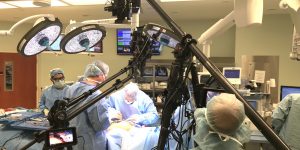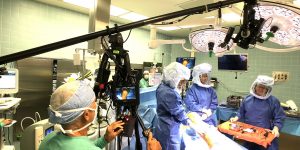Surgical Video FAQ
Why do we need surgical video?
Surgeons are visual professionals. They use their eyes as much as their hands and instrumentation. What better way to reach this visual professional than through video? Plexus Surgical Video Productions is uniquely positioned as the premier surgical video production and editing company made up of both operating room personnel as well as video professionals. We know how to get the shots, perform in the OR, speak the language, and think like a surgeon in the editing suite.
What does Plexus Surgical Video Productions do?
Plexus Communications is a medical video production company specializing in surgical procedural and product promotional programs. We produce academic programs as well as device company programs. Plexus utilizes the skills and talents of many other video artists, cameramen, animators, medical illustrators, and field personnel. Our emphasis at Plexus is in creating and producing whole programs using cost-effective, controllable pre-production, production, and post-production techniques. Plexus has produced multiple programs in all video genres, and we have extensive familiarity with all surgical specialties. Programs have been produced for: orthopedics, arthroscopy, open heart, vascular, general surgery, thoracic surgery, thoracoscopy, laparoscopy, gynecology, pelviscopy, plastic & reconstructive surgery, sinus endoscopy, ENT, urology, opthalmology, oral, maxillofacial, and neurosurgery.
What are the typical ways Plexus shoots surgery?
At Plexus every surgical procedure is assessed for video capture needs. For open surgical procedures we routinely use a two-camera technique with two jib (boom) arms and high capacity sun-gun lights mounted onto the cameras. It’s nuts to try to shoot surgery without jib arms, and at Plexus we have actually machined one of our arms ourselves to get just what we need in an overhead surgical jib. Open procedures require intense lighting, color balanced close to the surgical lights, so the surgeon can see into the wound unencumbered, and our cameras can see an even spray of light over the whole field. Top priority is that the surgeon must be able to see, and then we adjust to that. For endoscopic procedures where less light is required and even desired, we will use halide lights mounted as sun-guns controlled by dimmers. It’s rare when we do not use jib arms for shooting surgery, but there are a few procedures that don’t require it. Also when looking into deep, small wounds, we will often add the use of a laparoscope to look deeply inside a wound that no other camera could possibly look into.
I have never shot video before. How do I go about shooting a surgical procedure for my marketing plan?
At Plexus we take a lot of the work out of the marketing director and product manager’s hands. The first step is to fill out a simple email questionnaire about what kind of video program you want us to produce. Plotting out the details and contingencies at this first stage is essential to generating a proposal. Aspects of a production that often need to be considered are: the procedure that will be shot; the intended length(s) of the program(s); the primary audience; the genre; the intended display formats (DVD, web video, etc.); and the surgeon(s) you want to work with. From this information and a little more, we can generate a proposal. We will then provide you a set of guidelines for producing a video program that is mostly geared for the person that has not done video before, but sometimes even seasoned pros find these guidelines handy.
As a marketer, what is my role and how can I help expedite the process?
Once you have approved of the proposal, it’s time to look for a date to shoot the procedure. You probably have a surgeon in mind, and you have the relationship with the surgeon. The next step is to organize the shoot date in collaboration with Plexus and the surgeon. Plexus will send you an email as to the dates that are already booked, so we will not be able to shoot on those dates indicated in the email. It is best to notify Plexus a month or so before your intention to shoot, in case there are unusual circumstances that we need to prepare for. There are so many of these unusual circumstances simply on technical levels that we cannot begin to go into them here. Nevertheless, it is always good to notify Plexus early. Once a shoot date is arranged we will need to notify the operating room director and public relations for many hospitals and teaching institutions immediately. Sometimes it is even advantageous to notify the OR and PR before a shoot date is determined, to obtain any requirements that they may have. Once this is set, we are ready to go and shoot.
How do we decrease the odds of booking a surgery that wasn’t quite right for our purposes?
If it is at all possible, it is advantageous if the surgeon can schedule two cases of the same procedure on that shoot date. It is also an advantage if they are the same-sided cases, if those are extremities. Plexus is generally pretty good at getting all the footage we need on the first case, but sometimes the case may not be quite right, so it is always good to have more than one case. For long and rare cases we do not have this luxury. If it is a commonly performed procedure, it is good to have backup cases as well.
Also when a surgeon room-hops between two rooms, not only is it an advantage to schedule the important cases in one room, so that we don’t have to move video equipment between cases, but that the scheduler can schedule the same-sided cases in the same order that shoot date, so we don’t have to change the room around between each case.





